
The Great Wall camera is a bit of a mystery. A little bit of quality and a little bit of junk. A bit of history is in order, I think. Gathered mostly from this site. Stretch your legs and get comfortable, because this is going to be a long one.
Hailing from China, it was designed to be a cheap, all-around camera for students to use. It was designed by Bi Guoguang (毕国光...someone was nice enough to translate for me, so I'm correcting it throughout), but he graduated from a university with plans to work in the automobile industry. In June of 1956, he was assigned a position as the only plant technician at the factory that preceded the Beijing Camera Plant, became deputy chief of design, the testing branch chief, and then in 1984 became the director of the newly named Institute of Beijing Camera Plant. He retired (I think) in 1987. He worked with cameras using a magnifying glass as he had poor eyesight, but still worked with enthusiasm.
In the early 1980s, a meeting was formed with the director, secretary and research department to discuss the creation of a Hasselblad imitation. Bi Guoguang put forth a proposal to design a camera a based on the German Pilot, produced by Kamera Werkstatten AG in the 1930s. There was also a Taiwanese copy of the the camera, which lead him to believe that an imitation was possible in China.

Only one other team member agreed with the proposal, while the others held a negative attitude. Nobody could agree on a camera design.
Bi Guoguang chose the Pilot not only because of the relatively simple structure, but because he liked it. Having borrowed one and played with it for some time, he felt the camera was due for an improved redesign in China. The Seagull TLR was available at this time, but the price was too high to meet the needs of the people. He thought that if they produced a simple and durable structure with a single lens reflex and the use of 120 film, the camera must be popular.
According to his research, producing the imitation Pilot at the plant would not be a problem. Furthermore, with a design that allows a removable lens, a wide-angle lens and what translates as a Coke bottle lens could also be produced for the camera. Also, the camera lens could be used as an enlarging lens, giving the camera dual uses and reducing costs for the photographer.
In spring, Bi Guoguang was approached by the director, who stated that a final decision was made adopting the 120 SLR program, and asked for drawings as soon as possible.
Bi Guoguang called his friend, Deputy Chief Guo Zhong Ji, who agreed to drive over and help with the design of the camera. They spent more than 30 days working on the design for the Great Wall, producing almost 300 parts drawings. They were racing against time to produce the camera as quickly as possible. Normal production time for a new camera was two years, but they didn't want to spend that much time. Many workers joined in the mission to produce the 300 parts for the prototype, with the director approving overtime and bonuses (and apparently drinks all around). Everyone seems to have been very excited about the new camera.
The first prototype exposed some problems, mainly with light leaks, and some shutter issues.
At this time, a minister of the New China Machine Industry Ministry had two ambitions -- to produce something big, namely a hydraulic press for use in Shanghai shipyards, and something small, that being high quality cameras. Studying the Great Wall SLR prototype, he decided that he liked the camera very much, and he formed or joined (I can't tell...it seemed he felt awkward about taking over control of the design) a technology research group to improve upon the design.
The camera became a major project of Beijing Municipal Bureau of Instruments. The psychological pressure to produce a working camera was great, and after more than a month of research, breakthroughs were made, and finally the camera design was agreed upon by the China Quality Certification Center and production approved.
At this point, the first mass production of a simple China 120 SLR camera was born.
Bi Guoguang was awarded and also received 60 yuan bonus, equivalent to one month's wages (this is about $9 US today). He had planned to design and produce two more lenses for the camera, the wide-angle and the Coke bottle, as well as improve the shutter speed of the camera. However, there was not enough time to achieve these goals, and he was later transferred out of the department. Since then, this 'beautiful idea' of his life is a lingering regret.
The camera was sold in China for 115 Yuan (approximately $16 US) and was also exported to West Germany, mainly for use by students. It was sold in small quantities in Europe and the US as well, though considered to be 'low-grade goods' in these countries.
Multiple masks and spools were produced for the camera, allowing for 6x6, 6x4.5, as well as 35mm and 828, making the Great Wall camera the first universal SLR camera.

There have been subsequent models of the Great Wall, starting with the original, then the DF-2, DF-3, DF-4 and DF-5. There is supposedly a DF-6, but I haven't found any proof of this. Each model sports slight improvements, such as the addition of (I think) flash capability and a self-timer. There are also models labeled as Chang Cheng, which is just Great Wall in Chinese.
This is from the site...figure it out for yourself, as I have no idea what the poorly translated "with Pen" means. I'm assuming it refers to the self timer, as that was the first model with that particular addition.
Type 1 / early
Type 2 / Popular
Type 3 / with Pen
Type 4 / band Shoe Outlet
Type 5 / band Shoe Outlet, flashlight socket
I'm not sure if these cameras are still produced, or if those available are pre-existing stock. From the article, I gather that there is just warehouse stock. And I'm not sure about the production dates and when production ceased, etc. (and even what year production actually began...somewhere around 1984). But the camera has gathered quite a following, for reasons I will talk about next! Yes, enough of all this history stuff...let's check out the camera!
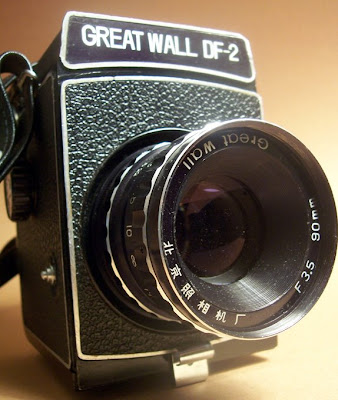

You can see the lens screws off...but the lens is part of what makes this camera so special! It sports a 90mm lens that has the following stops: 3.5, 4, 5.6, 8, 11, 16, 22. So you can get incredible depth of field and pinpoint focusing. But more on that later. Let's look at the rest of the camera. It has an exposure chart on top, in Chinese, so even more useless for me than it would be if in English. Windows on the back for both 12 and 16 shots, depending on the frame. I've looked at the wrong window a couple times when advancing, overlapping my shots. Nice slider to prevent leaks from the windows. The usual tripod mount.


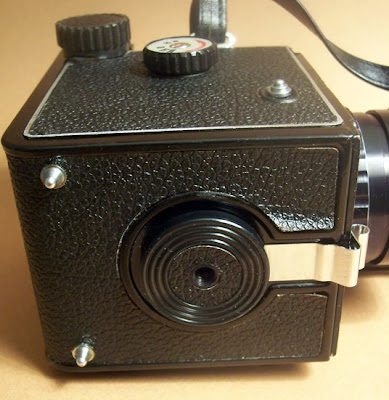
Opening up the back, it loads from top to bottom, like most TLR cameras. I'm sure, if you knew how to read it, the serial number would tell you when and where it was made. Probably what shift produced it. Or maybe it's just camera No. 0043558 out of however many were produced. Loading is pretty easy. The bottom spool fits very tight...I assume that the modern plastic spools have a bit more thickness on the ends than the older flat metal spools. It advances fine once the spool is in place...it's just a bit difficult to angle the spool into place.

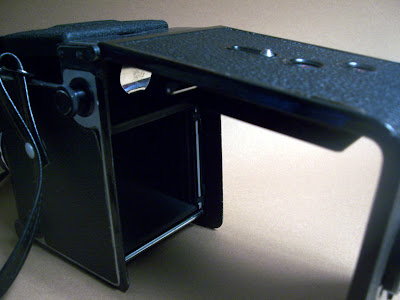
Looking at the top, it works pretty much the same as a TLR. It unfolds and you look down to frame.
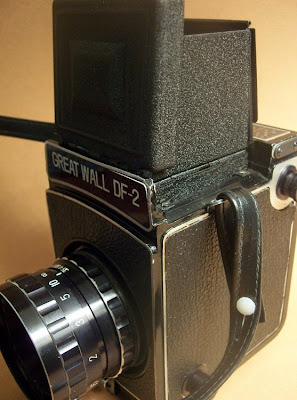
The view through the finder is super sharp, and because it is an SLR (single lens), what you see through the finder is what you are actually shooting. A TLR (twin lens) has you looking through the top lens to frame the shot, while the image is actually shot through the bottom lens. In fact, the mirror that shows you the image in the Great Wall is also the shutter.
Looking through the viewfinder at F3.5 (shutter wide open)...

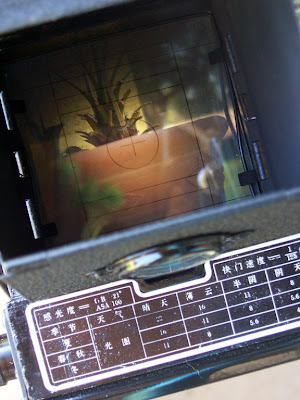
Okay, now a bit of the goofiness of the Great Wall here. Because you are actually looking through the lens to frame your images, you are at the whim of the f-stop. So, the smaller the f-stop, the smaller the hole to see through. Now, the film is sensitive enough that it does what it does. But that viewfinder...when you make the aperture smaller, you reduce the incoming light, in turn reducing image clarity in the finder. This is looking through at F11.
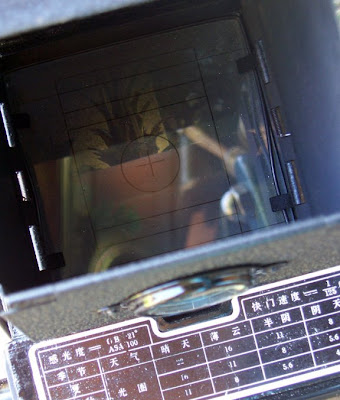
And then at F22.
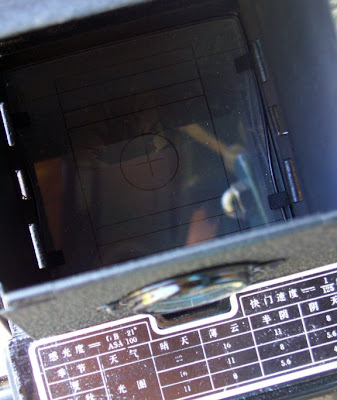
And the digital camera sees more than I can see with my eyes. All I see is a gray square. So...you mostly need to frame and focus your image at 3.5, and then switch it to 22 if needed. Very odd and not very user friendly, but just one of those 'things'.
Also on top is a magnifying glass for pinpoint focusing. You put your eye right up to the glass to focus, then flip it back to frame.
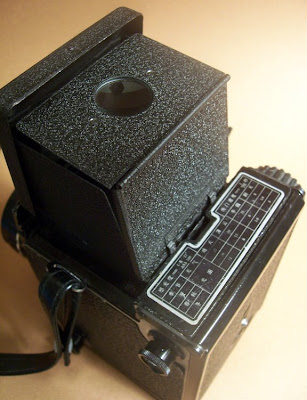
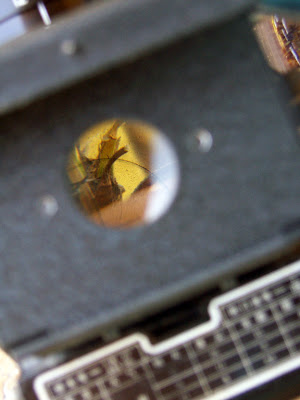
So, how does the camera work? Well, this is a bit funny, too. When I first got it, I thought it didn't work. Took me a couple minutes to figure out what was going on. I have a set of instructions...in Chinese. So here is the side of the camera.
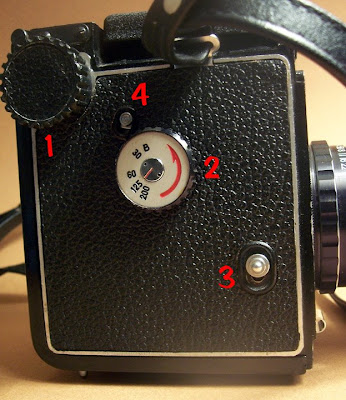
The film speed is set on the side. You have to pull the knob out and twist to set the speed. I didn't figure this out until I had already shot a roll. You can set it for Bulb, 30, 60, 125, and 200. So, #1, you advance the film, using the counter window to see your exposure number. You will hear clicks. This is the mechanism to prevent double exposures. If you want multiple exposures on a single frame, push #4 up, which disables the mechanism for a shot. After you have advanced your film. You twist #2 until it clicks. This is important! There is resistance, and what you are doing is cocking the shutter, actually lifting the mirror into place. If you don't twist it until it clicks, it will snap back. A friend used the camera once and noted that if you let it snap back, it can make the film slide back, creating overlaps. She didn't like that. Hasn't been a problem for me. So after cocking the shutter, you fire the shutter with #3. And you hear a big thunk as the mirror snaps back down. So...this is not a quick, point-and-shoot camera. You have to unfold the thing, spend some time focusing and framing, then go through all the steps to fire the shutter. Let's try this...my first crappy quality video on my blog. Not too keen on the video thing, but maybe just this once.
After all that, is it worth it? I think so. Again, with the Great Wall cameras, it's all about the depth of field, or bokeh as it is sometimes referred to (though that word can sometimes garner sneers). And you get this fantastic DOF for a reasonable price. Many people spend four times as much for just a lens that will give you decent DOF, as well as the camera to put the lens on. I'm not much of a camera snob, so I'm open to 'lower grade' cameras that I can actually afford and will actually enjoy, as opposed to having a bunch of overpriced equipment. Anyway, enough of that. Here are a few examples set at F3.5, with the super pinpoint focusing.





And just so you see it's not just a one-trick pony, you can also take some nice, sharp shots at 22 (and all the settings in between, of course).




These were all shot without a mask, leaving a slightly blurry edge. There is a 6x6 mask, but mine only came with the 6x4.5 mask. I'm not sure how you would count your frames with the 35mm mask and spool, but I'd like to get the entire set some day.
So that is the Great Wall camera! It's a nifty bit of communist Chinese craftsmanship. A big chunk of metal, a bit of hand-tooled industrial strength camera in your hands. Where can you find one? eBay is the best bet. Here's the killer, though...the price. Average price on eBay is anywhere from $120-$180, plus shipping (usually from China). If the price is lower, then the shipping is higher, which is the norm for eBay (and one of the things I really hate...only 99 cents! plus $49.99 shipping). This is a camera that originally sold for about $16 US. And...is still usually around 180 to 280 yuan in China today...or $25 to $45 US, depending on the model. Shipping from China outside of eBay usually runs from $20 to $35, depending on the total weight. Plus a wire transfer fee. Still, finding one directly from China cuts the cost of the camera in half. But you have to find one, and you have to be able to communicate to a willing Chinese seller in Chinese. It's doable, but you have to be committed to the process. I got mine from eBay, but I've successfully ordered other cameras from China.
For more photos, check out the flickr Great Wall Camera group. This site also has some information, including a PDF download of the different Great Wall models.
Check out this sweet looking camera, the Olympus Eye Flex:

I'm not sure if they were even publicly available (seems to be a prototype), but I'm keeping my eyes open for one, or a similar model.
Until next time. Heading up to Bedrock City this week! Excited.
Do want.
And this is pretty amazing, too.

Great post. Haha. You know, I have guessed every single exposure in every single picture I've taken so far with my GW. After a while, I think I just basically set it where I think it will yeild something as the previous film and exposure. Pathetic I know, but it works for me. I would love to actually use this right and get some beefy dof like I know it can do.
ReplyDeleteWhen I first used it, I set the wrong film counter and had ugly overlapping frames which killed most of my work...and it was decent work too. And that FWOMP sound is music to my ears. What a neat sound. I love my GW and its lens...but I mostly use it with the homemade getup. Right now, it has an inch of dust on it waiting to be loaded...the lens has more dust and I'm leaving it there. Prft...
beck
I want to see you put a Pola back on it... Skj.
ReplyDeleteooh, thank you for posting this. This was so helpful as I was figuring how to use my latest eBay acquisition! We'll see how the test roll turns out. So far my DF-2 seems to work fine, but it does have the most unholy musty stink to it. Any recommendations on how I might clean it?
ReplyDeletei've found the best way to get rid of camera funk is to just leave it out in the open, with the back open, for awhile. put it in a sunny spot. clean it u a bit, too. just wipe it down with window cleaner and a paper towel.
ReplyDeletea belated thank you to you! I will give your suggestions a try (life has been keeping me away from my treasures lately).
ReplyDelete*sigh*
ReplyDeleteI want one of these so bad, but some people apparently think this is the cool camera to be had so no chance to buy one on ebay, they are sold for ridiculous prices.
Thanks for posting this piece. I bought myself a US$20 Great Wall DF-2 a few days ago in Beijing and am rediscovering the joys of film. Cant wait to get the first roll developed!
ReplyDeleteHope you do not mind but i just linked your info on the Greatwall camera to my site. (www.sluik.info)
ReplyDeleteI am using this camera and an old Rolleicord Vb already quite a few years now after switching from the Agfa Clack and Click 1.
Compliments for your GOOD site.
Thanks for all of the great information. I'm headed to Hong Kong next month and hopefully I can find one of these cameras for cheap :-)
ReplyDeleteI bought a Great Wall about five or six years ago. The name "Great Wall" is all that is on the front and the lens. The lens, a 90mm 3.5mm seems reasonable after 5.6. The camera does have a self-timer, hot shoe and connector for handle flash such as the Pentax or the 120volt Honeywell. Except for universal ISO 100 in English and the lens meters, it's Chinese. There are numbers on the lens; 867752
ReplyDeleteThe only shots available are 16 marking it a 6x4.5, which I prefer. A leather case (possibly real) came with it in an unopened box, so the camera may have been new...?
It came from a seller on E-Bay living in South Carolina. The slip or info is no longer available, but the camera bought as "Buy it now" with shipping was well under $100.00US. Of course Holgas and Wocas have increased dramatically in past years. Twenty dollars was an extreme amount when I bought the first Holga and people were charging to modify and paint them. Only a little imagination could reap vast changes in aperture and shutter speeds.
There had only been one camera purchased with an odd odor, it was Russian and smelled of cosmoline grease from weapons. It's a Zenit and still has the odor after seven years
Enjoyed the site very much. It only proves one need not spend fifty thousand to make creditable images
Damn, now I am going to have to track one of these down and add it to my colelction of crappy cameras I love. I still seem to spend more money than I earn on cameras and film... oh well, i can't help being in love {sigh}
ReplyDeletehey, nice camera! have you any idea where i can get one?
ReplyDeletepeter
art0ep@web.de
this is really helpful, since the original instructions would be useless to us. i want one because of the lens...it's got the best bokeh i've seen in a medium format camera. it must be a copy of some German design.
ReplyDeletemark-b
Thanks a lot for this post. Just picked up one of these and I'm researching how to actually use it.
ReplyDeleteMuch appreciated.
Wow
ReplyDeleteGreat antique cameras
I have one of these great wall cameras for sale if anyone is interested -- joehagerman@gmail.com
ReplyDeleteHey Joe:
ReplyDeleteDo you still have the Great Wall DF-2 Camera?
If so, email me at succeedatphotography@gmail.com
Thank you,
Jane
This comment has been removed by the author.
ReplyDelete(Sorry...made an error in my previous comment)
ReplyDeleteI just purchased a DF-2 from eBay...so glad to find your detailed instructions...this is going to be so helpful...and I am soooo excited to receive it. Thanks so much!
I read your initial post with enthusiasm when it was first posted, and have visited the page often. I thought some extra infor may come in handy for those of us who are keen on these cameras.
ReplyDeleteSome time ago I bought a DF-2 - the Chinese branded one (non-export model)off ebay. Loved the camera, but the shutter was sticky and resulted in many lost exposures. I read that I could take the camera apart and lubricate the spring, but that was beyond my experience at that point. Primarily due to financial constraints following separation, I sold the camera on for the same amount I paid for it - these seem to hold their value well.
More recently - last year some time - I managed to purchase from a more reliable source a later model Great Wall.
My current model has a hot shoe and PC-sync port. If it has a self timer, I haven't found it. Rather surprisingly it has a shutter cable release port! On mine it is a small unlabelled hole above the shutter speed dial, next to the pop up hood. A standard cable release screws in fine and operates the shutter (once cocked). This makes the "B" mode suddenly infinitely more useable!
Could it be possible I have a DF-6? I suspect I have an export model given that the nameplate is in English. One thing is certain, this copy won't be leaving my hands regardless of circumstances for quite some time.
I purchased the Great Wall DF-2 in the early 1980's while working for my masters. I collect cameras, but only those I consider "great" (usually meaning they're made of metal and glass). IMHP the Great Wall is unique in equaling the (then) $1800 Hasselblad's photos for $120 from KEH. Much like the little wonderful EXA #1, it is whittled down to the very basics: fine lens, f3.5 to f22, medium format ability, single lens reflex, multiple shutter speed, heavy metal composition, rugged reliable accurate "guillotine " shutter -- and that's it.
ReplyDeleteYet with it I illustrated over a dozen natural history articles in Sports Afield, Defenders, Conservation, and many other slick magazines of the '80's. I mean, what a camera! Oh, I had the fancy stuff -- a complete Miranda system, Leica M4 with Leitz Summicron lens, even an Angineux 35mm that runs for over $2000 on eBay now. Sure I'm bragging but I not only got bragging rights, I'm an old white bearded codger witgh only memories to match your youth and hope.
So what I'm saying is the Great Wall 120 SLR was a match for my Leica M4. I also had a Mamiya C330 Professional TLR which was matched in results by the wonderful Chinese Great Wall DF-2.
I still have the Great Wall and it still works perfectly. An artist friend loves it because it seems to capture the colors of his paintings most exactly. It's definitely the best buy of my life. And by the way, that screw mount is the standard Leica M39mm mount . . . though of course you can't use Leica lenses on it. But you can use the GW 90mm lens on the Leica screw mount body with serendipity. As Larry of the Three Stooges would say, "Nyuk Nyuk". I remain your loyal and obedient servant, Richard Lee Fulgham, the moron of that stinking 20th Century who nevertheless knew his cameras.